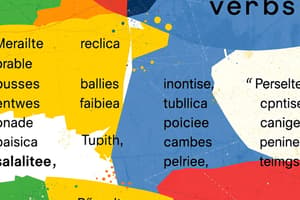Podcast
Questions and Answers
What is the past interior tense used to describe in Spanish?
What is the past interior tense used to describe in Spanish?
- An action that will occur in the future
- An action that is ongoing
- An action that occurs simultaneously with another action
- An action that occurred before another action in the past (correct)
In which context is the past interior tense commonly used?
In which context is the past interior tense commonly used?
- Informal conversations
- Written form, especially in literature (correct)
- Formal conversations
- Everyday conversations
What is similar to the vosotros form in Spanish?
What is similar to the vosotros form in Spanish?
- Past interior tense (correct)
- Conditional perfect
- Future perfect
- Present simple
How is the past interior tense formed?
How is the past interior tense formed?
Why is the past interior tense useful for learners?
Why is the past interior tense useful for learners?
What phrases are often used with the past interior tense?
What phrases are often used with the past interior tense?
Study Notes
- The past interior tense is the last major tense to be covered in Spanish, and it's used to describe an action that occurred before another action in the past.
- This tense is similar to the vosotros form, which is primarily used in Spain, and some learners may not need it, but it's useful for those who live in or plan to visit Spain.
- The past interior tense is used in written form, especially in literature, and it's not commonly used in everyday conversation.
- The tense is used to describe an action that had already occurred before another action started, and it's often used with phrases like "after", "when", or "as soon as".
- The past interior tense is similar to the past perfect indicative, but it's used in a more formal context, such as in literature.
- To form the past interior tense, the verb "haber" is used in the imperfect tense, and then the past participle is added.
- The forms of "haber" in the imperfect tense are: hubiera, hubieras, hubiera, hubiéramos, hubierais, hubieran.
- Examples of the past interior tense include: "when she had finished the song, the crowd began to applaud", "after we had eaten, we fell asleep", and "as soon as he had arrived, they began the meeting".
- The past interior tense is useful for learners who want to improve their reading comprehension skills, especially when reading literature in Spanish.
- Reading literature in Spanish is a great way to improve language skills, including structures and comprehension.
Studying That Suits You
Use AI to generate personalized quizzes and flashcards to suit your learning preferences.
Description
Test your knowledge of the Spanish past interior tense, used to describe an action that occurred before another action in the past. Learn how to form and use this tense in formal contexts, such as literature. Improve your reading comprehension skills with this quiz!




